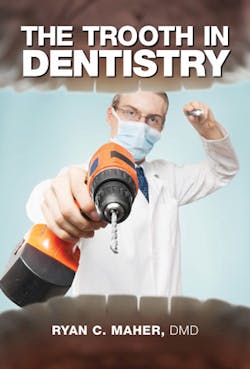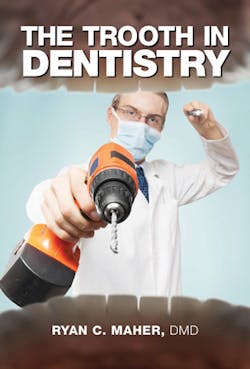The trooth in dentistry: Dentist's book aims to advise consumers about identifying unethical care
Dentist's book aims to advise consumers about identifying unethical care
BY Cathy Hester Seckman, RDH
If you're a writer who wants to catch the public's attention, you have to have a catchy hook. New Jersey dentist and author Ryan Maher has come up with a winner. "The Trooth in Dentistry," by Ryan C. Maher, DMD, was published in February as a consumer guide to the ethics of dentistry.
Dr. Maher has been practicing since 1997, and in the beginning was excited to help people and make a difference in their lives. He explains, "I would say my goal was to have patients walk out of my office extremely happy, even those who walked in hating dentists or in extreme pain."
Ryan C. Maher, DMD
Like most of us, his starry-eyed enthusiasm soon faded under the harsh light of reality. Within three years, he says, he had begun to question his career path as an associate dentist. He had begun to see what he believed to be unethical dentistry being performed. So he started taking notes.
Those notes eventually led to "The Trooth in Dentistry." Dr. Maher's goal is not to anger his peers, or have them think he is trying to give dentistry a bad name, but to heighten the awareness of patients. He wants dental consumers to know there is a very small population of dentists who are not practicing in an ethical manner. He also wants consumers to know they can-and should-become an integral part of a dental office/patient team. Only in that way, he believes, can we lower the incidence of malpractice, trauma, careless mistakes, and potentially lethal treatment in dentistry.
----------------------------------------------
Other articles by Seckman
- Orthodontic hygiene appointments made easier
- Patience with the kids: Pediatric pain control involves quick thinking to put kids at ease
- 'Junior is intolerant to ...' Having a reasonably coherent conversation with parents about food allergies and intolerances
----------------------------------------------
"Dentistry is not what it used to be," Dr. Maher states. "It can be pain free, comfortable, relaxing, and performed in an ethical manner that a patient does not have to second-guess as he or she walks out the door."
To that end, he has written the consumer guide. The book begins with a description of a patient in pain - not the best introduction for a reader afraid of pain. But Dr. Maher quickly reassures the reader that even one person in pain is one too many. That idea is a constant one throughout the book. A brief history of dentistry and a discussion of the importance of a smile are included next, but the final section of the chapter lists several reports of deaths attributed to dental treatment, along with a warning against substandard dentistry.
Car Maintenance Analogy
Chapter Two is dedicated to home dental care, and Dr. Maher introduces his pet peeve, medium/hard toothbrush bristles. "One of my patients," he recounts, "was resistant to switching to the soft brush. He believed the hard bristles were ... better" and that regular checkups weren't necessary. By the time the obdurate patient finally appeared in the office, "he needed five root canals and five crowns." Warnings against a poor diet and descriptions of correct brushing and flossing technique are included, but, curiously, the dentist doesn't mention other methods of interdental cleaning.
In the next chapter, Dr. Maher draws a parallel between oral health care and the care of an automobile. "If you skip that simple oil maintenance for too long, your engine explodes and then what are we talking about? Big dollars. ... This is exactly how it works with oral hygiene and care."
I wonder if he can hear us all applauding as we read. Isn't this the same kind of analogy we've been using for years? I love the simple, direct, patient-centered approach of the book, with a liberal sprinkling of humor and self-deprecation: "... gloved fingers pry your lips this way and that, and what's with that little vacuum cleaner ...?"
Dr. Maher is not afraid, though, to tackle more serious issues: "How do you know if you have the 'wrong' dentist or a 'bad' dentist?" He takes care to point out that he is not trying to be malicious or to attack his fellow dentists-all he wants to do is raise awareness in dental consumers and point out to them what a standard of care should look like. He encourages them to ask for tours of the office, including the sterilization area, and to ask questions and require answers. He reminds readers of the 1990s case of David Acer, the dentist who infected six patients with HIV virus because of sloppy sterilization procedures.
To avoid rushed or careless dentistry, Maher advises, people should avoid being the emergency patient who waited too long for treatment and has to be squeezed into the schedule. That kind of situation, he points out, can lead to less than perfect care. (More applause, right?)
Chapter Four deals with choices and treatment plans, guiding patients through the complexities of decision-making. There's nothing wrong, he says, with being presented with an ultimate treatment plan. The best dentists, in fact, should first recommend the treatment plan they would want for themselves. If that isn't possible, patients should be offered plans that cover all varieties of financing options. The best dentists, he says, respect and allow for medical histories, oral health needs, and current life circumstances without sacrificing their ethics or their concern for the patient.
"Even the less expensive treatment plan," he asserts, "needs to be well begun and then seen fully through."
Detecting a Clean Office
The sterilization issue gets more attention in Chapter Five, "Is Your Dentist's Office Hazardous to Your Health?" Several news stories are presented of dentists who exposed their patients to HIV and hepatitis, and subsequently lost their licenses. Dr. Maher asks several questions: "Does your dentist open the sealed bag of sterilized tools in front of you? Does he reach over and open a drawer and pull (an instrument) out of that drawer, cross-contaminating everything he touches?" He also points out that every office should be testing its autoclave on a regular basis, and patients should feel free to ask about that.
He deals with other safety issues, including hiring trained employees who have all required licenses, and using reputable labs. He touches on universal precautions and infection control standards, as well as the importance of postoperative instructions. "If your dentist pulls a tooth and says nothing but, 'We got it! See you later!' you should be worried."
Chapter Six deals with two issues that are sensitive ones for dental employees-the ethics of the boss, and the business sense of the boss. The issue that disturbed Dr. Maher most as an associate dentist was being told to "find something wrong ... anything" with every patient. He's also been surprised at the numbers of dentists who have no business skills. "Since opening my own practice, ... I have invested tens of thousands of dollars in business management courses." Don't we wish all of our employers would do that?
Dr. Maher encourages dental consumers to do research, "trust your gut," and raise the shields if something seems to be "off."
The seventh chapter deals again with "upselling" dentistry to make money, but it's right here that he risks alienating every hygienist who reads this sentence: "Upselling at your dentist might mean a $600 cleaning is suggested, when in reality you only need the basic $150 treatment." If he had stopped right there and explained the different meanings of words like "cleaning" and "recare" and "periodontal maintenance," he would have done potential readers a greater service.
In his defense, Dr. Maher says he wanted to keep things as simple as possible for the average reader, without getting into lengthy explanations. "The book always points back to going to your dental office and asking questions. I wanted to bring in the concept that everyone in the dental office is there as a team to help you, so be part of that team."
Chapter Eight offers suggestions for dialogue between dentist and patient, and again points out the value of researching any potential dental provider, trusting one's instincts, and not being afraid to ask questions and require answers.
In the final chapter on choosing a dentist, Dr. Maher is careful to point out that a reader may already have the perfect dentist for them. His goal, he says, is not to place all patients on high alert, simply to prompt those who need a change. He then offers a link to his website, www.TheTroothInDentistry.com, where he has begun to compile a list of what he calls "honest and ethical dentists," organized by zip code. There, he says, consumers will either find dentists Dr. Maher knows and approves of; dentists who have unparalleled reputations; or dentists who exhibit stellar credentials and provide top-notch references. "I want dentists to approach me, or have a patient approach me, and say, 'My dentist is solid and great. Call him, talk to him, and I guarantee you'll want him on your site.'"
Finally, the book's appendix includes a list of questions to ask before choosing a dentist, plus a list of ideas that include taking an office tour, talking to employees in private, and checking the state dental board's website for disciplinary action. The final section lists red flags that wave in both directions: online reviews that might be simply malicious, or a dentist who is rude or abusive.
Overall, Dr. Maher has produced a fine book aimed at dental consumers. If all of our patients could read the book, we, as dental office employees, could feel much more confident that our patients have the knowledge to demand the best from us and from our employers. Besides being available for sale on Maher's website, "The Trooth in Dentistry" will be sold at major online booksellers such as Amazon and Barnes & Noble. RDH
Cathy Hester Seckman, RDH, has worked in pediatric dentistry for 12 years. She is a frequent contributor to dental magazines, works part-time as an indexer, and is the author of two novels and more than a dozen short stories.


